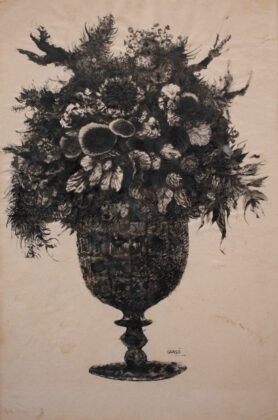Sansó’s darker side is explored in a new exhibit
MANY of us know Juvenal Sansó for his exuberant floral paintings, his acclaimed etchings, and his azure-and-green Brittany series. But Fundacion Sansó’s latest exhibit, “Sansó: Prized and Personal Featuring Works from the Marlon and Marissa Sanchez Collection,” does not include florals paintings. Instead, it includes portraits of the denizens of Paris, evil-looking black bouquets, and Brittany landscapes that have an ominous cast over them.
It is the second in the series of “Sansó: Prized and Personal” exhibits which show the artist’s works owned by different private collectors. Composed of 27 works on paper and canvas, the Marlon and Marissa Sanchez Collection focuses on Mr. Sansó’s expressionist Dark Series or Black Period, including his Grotesqueries, his Black Series portraits created in 1950s to ’60s Paris, and Brittany Series paintings.
Marlon and Marissa Sanchez started out as art dealers but eventually collected Mr. Sansó paintings instead of selling them. What transpired was a love and deep respect for the artist and his work, and their collection gives us a detailed look at one the artist’s seminal art phases.
HINTS AT A TRAUMATIC PAST
This Black Period was Sansó’s way of dealing with his wartime trauma. After migrating to Manila from Reus, Spain in 1934, his family lived a relatively comfortable life until World War II broke out. The teenaged Sansó was mistaken by Japanese soldiers as an American and was badly beaten. Soon after, he was critically injured during the bombing of Manila. He survived his severe injuries and became a conductor for the bus his father operated in the post-war city.
These two episodes scarred him emotionally. As an art student in the University of the Philippines, and later while sitting in on classes at the University of Santo Tomas, Mr. Sansó decided to eschew the happy, bucolic Filipino scenes that were popular themes. His painting, The Incubus, which won him the grand prize at the Art Association of the Philippines, showed early traces of this dark period. It is described by Fundacion Sansó director Ricky Francisco in the book After the Deluge Comes the Dawn as “…nearly too grotesque to be human, reflected the trauma from his horrific and dehumanizing experiences of the war, and it was a clear departure from what was socially acceptable as fine art back then.”
BLACK PERIOD IN PARIS
“When you see his Dark Series, you’re struck by a deep emotion. You could see how his trauma is translated as art,” Ms. Sanchez said when asked why she and her husband focused on the expressionist works. “You see his heart. He is not one-dimensional, unlike many successful artists,” Mr. Sanchez said.
In 1951, Mr. Sansó studied art in Europe, first in Rome, and then settling in Paris. The young student was unhappy at first, but then began to observe his colorful new surroundings. It was here that, according to art scholar Dr. Rod Paras-Perez, that he fully embraced his Black Period. Mr. Sansó did not draw elegant Parisiennes; he focused on the underbelly of Paris: the smirking habitues of its cafés, comical Can-Can dancers, and other characters bordering on the monstruous. In Dr. Paras-Perez’s book, Sansó admitted that these also reminded him of the dangerous commuters he encountered daily while working on his father’s bus in Manila.
To reach a wider audience, the “Sansó: Prized and Personal” series of exhibits will culminate in the publication of a book of the same name. This book will give an insight into what compels these collectors to acquire his art, and will show the vast range of styles and mediums Mr. Sansó covered in his career.
“Sansó: Prized and Personal Featuring the Marlon and Marissa Sanchez Collection” will run until Aug. 2 at Fundacion Sansó, located at 32 V. Cruz St., Brgy. Sta. Lucia, San Juan. The museum is open from Monday to Saturday, 10 a.m. to 3 p.m. For more information, follow Fundacion Sansó on Facebook, and @fundacion_sanso on Instagram. For inquiries, e-mail fundacionsanso@gmail.com.






